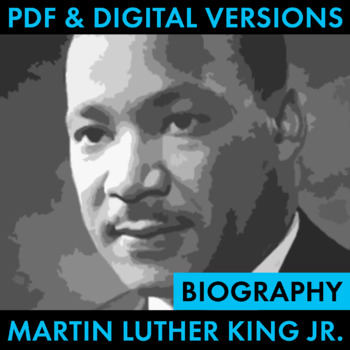Martin Luther King Jr. Biography Research, MLK Biography PDF & Google Drive CCSS
- PDF
- Google Apps™

What educators are saying
Description
Skip the typical Martin Luther King Jr. introduction lecture as you launch a study of the civil rights movement and, instead, empower students to find their own interesting facts about King’s life with this “V.I.P. of History” print/post-and-go biography activity.
This single-page worksheet (includes printable PDF and Google Drive versions) is a powerful research organizer that’ll get students digging deep into Martin Luther King Jr.’s life and historical impact.
Please note: This download does NOT include a specific article or links to defined articles. It is an organizer tool for students to use as they conduct their own research. In my experience, students take more ownership of the material when they are the ones to research and discover the elements that make a historical figure’s life fascinating. They’ve seen enough of our introductory slideshows; this time, let your kids do the work and discuss/determine what they think is meaningful about King’s life.
Here are a few suggested uses for this flexible research tool:
1. Book your school’s computer lab or have students access Martin Luther King Jr.’s biographical information on their own devices. Assign students to work solo or in teams of two. Once the grids are complete, have students share and compare answers in small groups, focusing on the four interesting facts they discovered, the meaningful quotes, and the important campaigns he helped organize. Then, pull the students into a full-class discussion, having each group present an interesting fact, quote, or campaign until every team has contributed. No repeats allowed.
This assignment works great as an “into” activity, but it could also be a “through” activity to add variety to your in-class routine as you work through a longer unit.
2. Assign the worksheet as a traditional homework assignment. Launch the discussion mentioned in #1 at the beginning of the next class period.
3. Use the grid as the beginning assignment to a larger project where students learn about several people from the civil rights era. Later, this research worksheet information be turned into a compare/contrast essay or a speech presentation, if you wish to expand the assignment. (Biography sheets on a variety of famous figures are available in my shop if you want to vary speech topics within one class.)
4. Use as an emergency sub plan.
I hope you and your students enjoy this activity! If you need a V.I.P. of History research organizer for any person not currently offered in my shop, please send a message to me through the “Ask a Question” tab and I’ll do my best to quickly make that happen.
Want to include Coretta Scott King in your students' research unit? Click here for her biography grid: https://www.teacherspayteachers.com/Product/Coretta-Scott-King-Biography-Research-Grid-King-Activity-PDF-Google-Drive-7422698
This item is not included in any of my other materials. Also, the image on the student PDF worksheet is slightly ghosted to save printer/copier ink. I encourage students to doodle/shade in that space as they work.
Thanks for stopping by!
Image credit: Nobel Foundation, Wikimedia Commons, Public domain




